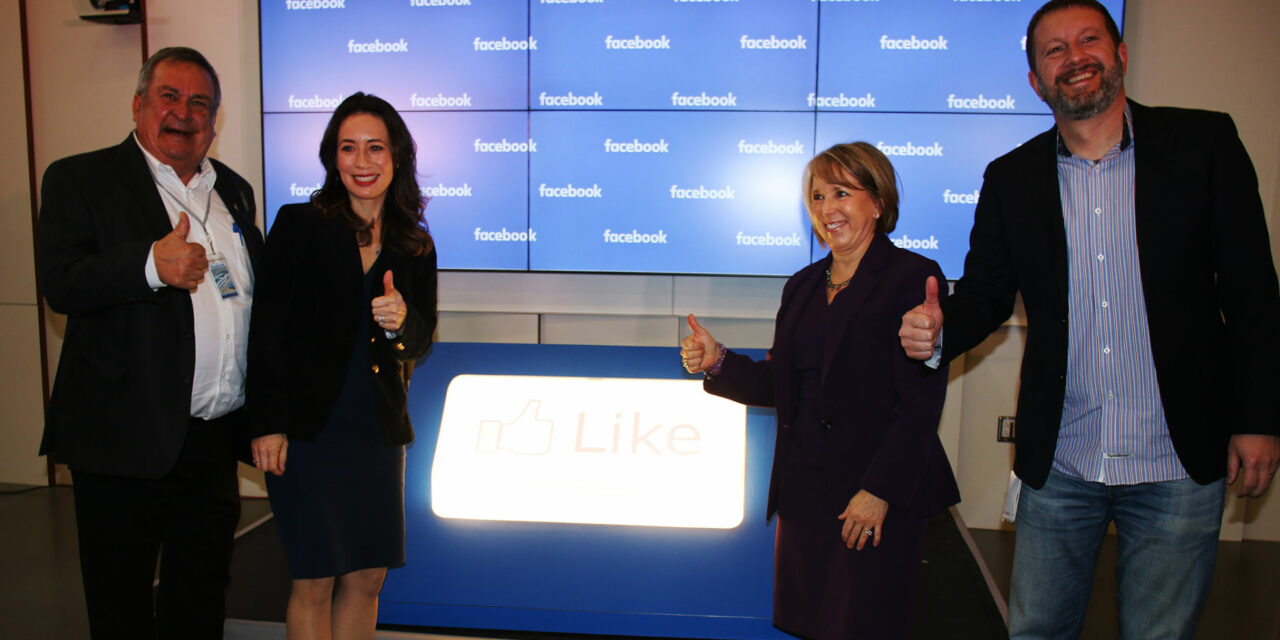LOS LUNAS—Gov. Michelle Lujan Grisham attended Facebook’s Data Center official grand opening in Los Lunas on Feb. 7, along with about 50 local and state officials.
The event included tours of the first completed building of Facebook’s $1 billion project.
“We are online — we have traffic passing through the data center and we have about 150 people here today supporting day-to-day operations of the data center,” said KC Timmons, the director of Facebook Data Center site operations.
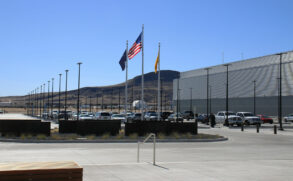
The first of multiple buildings at Facebook’s Los Lunas Data Center opened in February. The social media giant is building a total of six buildings on the site.
News-Bulletin file photo
Timmons told the crowd the facility is the “cloud,” where videos, photos and memories posted on Facebook, Instagram and WhatsApp are stored.
“This is where that data resides; this is the physical manifestation of Facebook the platform,” Timmons said.
Rachel Peterson, Facebook’s vice president of infrastructure, said the campus now represents more than 128,000 cubic yards of concrete, 14,600 tons of steel, enough conduit to connect Los Lunas to Houston, more than 4,000 miles of wire and 480,000 miles of fiber, more than 3.5 million cubic yards of earth, and the work of an average of 1,100 workers on site each day.
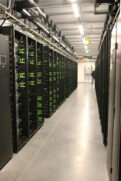
The completed building’s first floor is devoted to data storage, which resembles a library with rows of shelves storing packs of 8-track cassette-size hard drives. This is the “cloud.”
“As part of our commitment to the community, we are building one of the most advanced and energy efficient data centers in the world,” Peterson said.
The completed building and the adjacent buildings under construction represents about 970,000 square feet, and each building stretches the length of four football fields, Timmons said.
The second building is expected to be completed by the end of this year, and the remaining four of the six buildings are to be completed by 2023.
On the north side of the data center is a 10 megawatt solar farm — one of eight to be built in the state to serve as part of a 396 megawatts system to run the data center on 100 percent renewable energy by 2020.
Data centers also use 38 percent less electricity and are 80 percent more water efficient than the industry average.
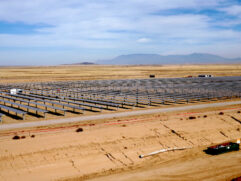
On the north side of the data center is a 10 megawatt solar farm. The data center hopes to be on 100 percent renewable energy by 2020.
Facebook officials estimate the solar- and wind-powered energy projects will result in an estimated investment of more than $800 million and 1,300 jobs in the state.
“More importantly, New Mexico is being recognized as a leader in renewable energy and we are proud to have played a part in that,” Peterson said.
Gov. Lujan Grisham thanked Facebook and said there are a number of renewable energy proposals in the Legislature right now, including having New Mexico set some of the strongest renewable portfolio standards in the country.
“And our bill would set those at 50 percent by 2030 and get to 80 percent by 2040,” Lujan Grisham said.
The governor told the audience that New Mexico really suffered as a result of the recession and lost several of its construction industries.
“And who made a major investment to help us rebuild that part of our infrastructure in our state? Facebook did,” she said. “And we are very grateful … “
The drive onto the Facebook Data Center campus is lined with tall brown iron fences enclosing smooth, white concrete data storage buildings.
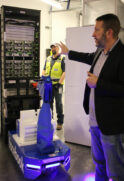
KC Timmons, the director of data center site operations, explains how Facebook user’s photos and videos are stored.
Like the completed building, each of the three H-shaped pairs of buildings will be connected by administrative offices, an employee cafeteria and restrooms.
The first floor of the long building has numerous aisles of what look like big black lockers or library shelves. They house trays of boxes holding packs of six, 8-track cassette size hard drives. Each six-pack can hold two billion photos, said Ben Stanfield, a site operations capacity team member.
The second floor houses the hard drives’ ventilation and cooling system and is pressurized to filter out all dust and wind particles.
The consensus among state economic development and Facebook officials seems to be that the data center will be an economic driver, supporting hundreds of jobs in and around Valencia County.
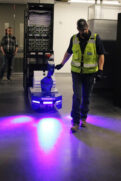
The purple light leads the way as a logistics technician transports racks of servers to be stored in one of the data halls at Facebook’s Data Center Campus in Los Lunas.
Many are already employed at the Los Lunas facility, including culinary staff, security and communications staff, as well as mechanical engineers from Belen, Los Lunas and the Albuquerque area.
There are logistics experts that support all of the shipping in and out of the data center, and Timmons said at full build out the campus will employ about 200 to 250 full-time staff.
Facebook is currently hiring for a variety of positions. Visit the Los Lunas Data Center Facebook page for more information.
Fiber, utility and renewable energy businesses usually beef up production in the wake of a new data center, as well as businesses that support construction, such as all the subcontractors, electrical, plumbing, HVAC, and hopefully visitors to the village hotels, restaurants and shops, Timmons said.
“It’s been a huge economic boon to our community,” Mayor Charles Griego said. “And the social impact — allowing people to stay home and work in Los Lunas and not have to travel. I think it’s been very positive; it’s been very uplifting for our community.”
Facebook has brought the village of Los Lunas to the attention of the world, the mayor said.
“Hopefully in the future, we’ll have some exciting announcements based on the standing work that Facebook does in the community,” Griego said.
Since Facebook broke ground in October 2016, the village has seen a rapid increase in gross receipts tax revenue, said Greg Martin, the village administrator.
Martin said in fiscal year 2016-17 before Facebook, the village’s annual construction GRT total was a little better than $3 million. In 2017-18, the first full year of Facebook construction, the annual GRT total was $10,078,069, a $7 million difference.
Not all the GRT revenue can be attributed to Facebook alone. There have been other substantial construction projects in the village.
“Still, if you look just at the construction GRT line graph, you can see that the monthly average increased from below $200,000 per month in prior fiscal years, to about $800,000 per month in 2017-18, and about $600,000 per month on average so far in 2018-19,” Martin said.
The $10 million state LEDA grant awarded to Facebook is used for infrastructure that benefits the village as well. Facebook is also investing in the community by providing grants for local nonprofit organizations and agency projects. Awards will be announced next month.
The social media giant is partnering with the state to permanently restore wetlands in Carson National Forest. The restoration will lead to more clean water that will create a better environment to both wildlife and livestock, Peterson said.
